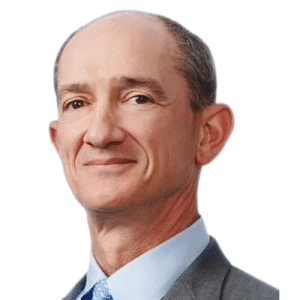This week’s Investment Q&A from FundCalibre is with Alec Cutler, manager of the Orbis Global Balanced fund. Alec provides a brief introduction to the fund’s philosophy and the unique charging structure of the fund, before turning to macro events. As a self-proclaimed contrarian investor, he highlights the importance of patience and being comfortable with being alone and potentially being wrong – or early – in investment decisions.
(Recorded 23 June 2023)
Please give us a brief introduction to the philosophy behind this fund and what sets it apart from the others.
We spent about two years doing research on the best way to create this fund with longevity in mind and so that it produces a moderate risk portfolio for any kind of investing environment. We came out with some results that make it look quite a bit different and behave a bit different to a typical ‘60/40’ fund.
The first difference is that we have very wide latitude on our asset classes. We can be high equities or low equities, high fixed income or low fixed income. We can also hedge some of the equities, which enables us to buy some equities that might be a bit higher risk, but then hedge out the market risk.
We also have the ability to invest up to 10% in commodities – for us, this means gold. Plus, we manage and ameliorate some risk by managing the currencies, which is a big difference to a lot of global 60/40 type funds.
Another USP for the fund is that there’s no 40% share that’s in fixed income that someone else manages, and 60% that an equity manager manages, and then we have some commodity person do this, and then we get a different person to do the currency management. Each and every stock has to compete against every other stock and bond. Every bond has to compete with every other stock. The hedged equities, the equities that have the market hedged out, they have to compete with straight equities or lower-risk moderate equities and fixed income – something that sets this fund apart from the usual 60/40 funds.
What then results from that ‘bottom-up fight for capital’ cage match in the portfolio, is our asset allocation; we don’t do top-down asset allocation. We don’t scratch our chins and say we want to increase the equity weight by 10%; we allow that fight for capital amongst the fixed income and equity ideas to determine where that ratio sits. That’s very different and thus far it feels like a better way to go than to try and pretend that we can time the markets because we know we can’t.
As a self-proclaimed contrarian, can you give us an example of that contrarianism and what makes you so different to your peers?
We tend to look at what the market is most worried about, and then not worry about it. One good example would be seven, eight years ago, no one wanted to own Microsoft, Apple, Facebook as it was or Google in 2013-14-15. They were really inexpensive. In fact, we were buying Apple and Microsoft at 10-12-13x earnings, which was a super low multiple for those names because they had failed to produce the earnings growth that people felt was being promised in the 1999-2000 era. And we were buying those names which was a contrarian purchase.
We sold those names in 2017-18-19, when they were hitting 20-22x earnings, and, in hindsight, maybe we should have held onto them for a bit longer. But the money from selling them would have gone into energy stocks in 2018-19 and this was the time when no one wanted energy stocks and gold miners and copper miners, when the world was becoming fascinated by this notion of only buying things that delivered high return on invested capital. And that’s when we sold our high return on invested capital names. We want to give the market what it wants, especially if it’s going to pay a lot for it.
Does being a contrarian teach you to be very patient as an investor?
You have to be thick-skinned. Not only do you have to be comfortable being alone, you have to be comfortable being alone and face the prospect of being wrong – or really early, which exemplifies the need for patience! One of the litmus tests for me as a contrarian is if I go to a cocktail party and someone finds out I’m a money manager, lots of people want to come and talk to you and get some new ideas or something, and when I mention the name, they wander off. Then I know that’s a good contrarian name.
In a previous interview, you said that the Fed reminds you of your father yelling at the TV trying to change the score in a baseball game. Are you worried that the Fed has not got a grasp of inflation yet?
I don’t believe the Fed has got anything right! In 2009, when he did the first quantitative easing, Ben Bernanke was asked if that was just monetising government debt. And he said no. If it was permanent, then it would be, but this was only going to be for a year or two. That was USD 3 trillion dollars, and now we’re at USD 8 trillion dollars and counting. It hasn’t gone anywhere in 15 years, it’s only grown.
And then we started with fiscal stimulus in 2020 when the central banks told governments to stimulate the economy and to issue money and, within months, the government had spent USD 7 trillion – USD 7 trillion! Everyone seems to forget what a trillion is; for example, if you go back a trillion seconds, that’s back to 30,000 BC! So we have this massive amount of stimulus, and the Fed is sitting there saying that we’re going to get back to 2% inflation, no problem.
Initially though, they said there was no inflation. Then they said that it only transitory. And then they acknowledged that we did indeed have inflation, but that they had the toolbox to get it down. But I learned recently that the government’s confidence in getting inflation back to 2% is that their genius economists – that all went to Harvard and Yale and Oxford and Cambridge, of course – that all the models they use have 2% as the terminus and every model magically winds up going to 2%, because that’s what the maths tells the model to do. It doesn’t make any sense to us.
As an engineer, I look at it very simplistically – and I’ll use the analogy of a layer cake. So, they say 2% is normal healthy inflation for an economy – that’s your first layer. But consider what else is going on in the world; you had 40 years of rates dropping from a peak of 15% in 1981. 40 years later, 20% of the debt in the world is in negative yield – so, dropping rates for 40 years is deflationary? Now it’s going up, that’s an inflationary impulse. So, back to the cake; here’s my cake 2% and now I add a layer on to represent that inflationary impulse.
Then Ronald Reagan and Margaret Thatcher crushed the unions in 1981 and 1985 respectively – Reagan, the air traffic controllers and Margaret Thatcher, the coal miners. That was the peak in union power. Unionisation in the US hit its lowest level ever in 2021 but at the same time, the polling popularity of unions is at the highest level it’s been since 1965, and unemployment is at a very low level. Unions are getting more powerful so now you’re starting to see the pendulum swing the other way on union power. That’s another layer on our cake above 2%.
Then we get to defence spending. When I graduated from the Naval Academy and was commissioned as an officer in the Navy, the Berlin Wall came down and we all suddenly wondered what our job was. We joined up to fight the Russians, and with the collapse of the Berlin Wall, we had nothing to do. This then ushered in a 35-year period of peace dividend, and defence spending dropped and then dropped some more.
Personally I think defence spending is counterproductive; building a tank does not make anything more efficient. It enables you to have ESG; it enables you to have blue hair if you want to have blue hair, but it doesn’t add to your productivity. Defence spending in the UK in 1989 was 4.2% of GDP; it bottomed below 2% in 2018-19, and now it’s starting to creep back up. All of Europe dropped – anywhere, everywhere in the world; the US dropped from 6.5% to 4%. That has all turned. All that entire turn is inflationary because it’s not productive. So, that’s another layer on our cake.
People like to talk about productivity and technology, and they say that technology makes everything cheaper which is deflationary. I disagree. This is being confused with the outsourcing we did to China, when we moved to more of a tech economy and a service economy in the US – having moved all the ‘dirty’ manufacturing to China where it was cheaper to do. That started coming back after Trump put sanctions on China and, in 2018-19, you saw a major increase in infrastructure spending in the US as everything is getting reshored back to a more expensive place. That is inflationary.
Again, on technology, the only real spurt in tech-driven productivity gains was between 1995 and 2005 – Windows ’95, the Pentium chip, email and the very beginnings of the internet. We went from doing things by hand and mail to doing things by computer and email, and using the internet for research. And then that productivity technically stopped in 2005 until 2012 when the iPhone appeared, and Facebook bought Instagram and everyone went from being productive on their computer and sending emails to having a phone and looking at their phone and looking at cat videos. And all our children stopped studying and started trying to figure out different hairstyles and why their friends were having more fun than they were.
So our cake is getting bigger with another inflationary layer being added. And all of these impulses come in 30, 40, 20-year cycles, so-called Kondratiev waves. But there’s one impulse that is not a cycle at all, and it is the fight against global warming. This is a brand new impetus and could also be the most impactful of them all.
Jeremy Grantham, who is very pro-green and pro-electrification, suggested we would have to spend USD 100 trillion to counter global warming. And that spending is not productive, it is counterproductive. For example, if you take a cement factory and you say that they can no longer use natural gas to make the cement – it takes a lot of heat to make cement – they have to use electricity. If it was more efficient to use electricity, they would have used electricity in the first place. But first of all, it costs a billion dollars to change that plant over and that cement manufacturer needs a return on that, so, he’s going to amortise that through his prices. And then it’s going to be more expensive to make that cement with electricity, so the price will subsequently increase. Greenflation is going to be more expensive and I think the hundred trillion dollars is just the ante.
Are there any other areas apart from the UK that you’re finding attractive?
There are certain utilities in the US, particularly on the gas side that are looking promising. Japan also looks interesting as it’s been getting cheaper for a long time. 40 years ago, we had zero weighting in Japan, and people thought we were crazy because the global index was 35% weighted in Japan; it’s now about 4%. And the stocks are really attractive. And the government has now come around to the fact that they need a strong equity market and are pushing very corporate and equity positive regulation. So, we’re very overweight in Japan.
And we’re seeing Korean banks selling for 0.3, 0.4 x book price because the government has treated them as utilities to support the exporters. Now they’ve realised that all they’ve done is increase the cost of capital for the entire economy, because the banks are so poorly structured, and they’re trying to restructure the banks so that they can be competitive globally. That’s going to help the whole economy, but it helps us when we’re buying up most of the banks in Korea.
What is your take on the revived bond market at the moment?
Bonds have repaired themselves from being just pure, reward-free risk where there’s just no upside when you’re getting 60 basis points a year in interest for nine years of duration risk. That was not helpful and as mentioned previously, we had the flexibility to not go there, whereas a lot of 60/40 type funds have no choice; they just have to pick the best of the 10-year Treasury bonds. We found gold to be much more attractive and it has performed much better than those bonds. But what we’re seeing now, the fixed income weighting three years ago would’ve been 10% in cash basically. Now it looks a lot more like 10% in Treasury Inflation Protected Securities that are yielding 1.6% to 2% real, plus all the inflation until the bond is due. This is us believing that inflation will is going to be quite a bit higher than 2% on average over the next five, seven, and nine years. We can protect our clients with TIPS that way and give them a real return.
There are some corporates that are able to compete with equity opportunities and we still have some short-dated debt, one-year Treasuries that are yielding 5.5%. People are scared of those one-year Treasuries because if you’re running a bond fund or you’re running a fixed 60/40 fund, you have reinvestment risk big time, right? So, 5.5% for a year is not great if you’re going to have to reinvest at two. We have every asset class that we can invest in after one year. So, we have much, much less reinvestment risk running the Balanced fund the way we do.
People still believe the Federal Reserve when they say that we’re going to go back to 2% inflation, and it’s only when the faith in that disappears, and when the implied inflation rate goes to 4% or 6%, that bonds will truly be attractive versus equities.
Gold was one of the fund’s largest single holdings. You described it as the first crypto because it was issued by God. What’s the attraction specifically today?
I started arguing with the crypto bros who said Bitcoin is the new gold. But I had to explain to them that everything they describe about their crypto is modelled off gold. Like the algorithm for Bitcoin is modelled off gold. And my last parting shot was, gold is the crypto issued by God. And I’d rather have that than Bitcoin who no one will put their hand up and say they authored. And I actually wound up writing a white paper on gold. I didn’t hold gold until 2018, until the gold miners started going out of business and because that was also the beginning of unfettered money printing.
This is not a gold bug fund, loaded up with tons and tons of gold. But it does have a lot of real things in it because it’s not just gold that goes up when you’re debasing your currency. It’s anybody that is making any thing, whether it’s copper or semiconductors or has got a lot of semiconductor exposure.
Finally, tell us about Orbis’ unique charging structure
If we perform in line with the benchmark – the 60/40 index – then we’re not worth our salt if we can’t beat that and we don’t want to get paid anything. We get paid nothing. Zero. If we outperform the benchmark, then 40% of the outperformance would go into a reserve bucket. And if we continue to perform well, that bucket would start building up. We would drain a fee from that, at a fairly slow rate – I think it’s 30%, I didn’t review my notes for what it is in the UK, but I think it drains at a rate of 30% per year – and if we subsequently underperform, it drains back to the fund at 40%. What I really like about it as the portfolio manager, is it takes the relative performance from being like this – very uneven – and it chops off the tops and the bottoms and smooths that out a bit.
We wanted to create the most aligned and fairest fee we could that was still economic. We have to outperform by quite a bit before we even get an industry standard fee. Full stop. And if we outperform way more than that, nobody seems to complain. If we subsequently underperform, that watermark sticks at the high relative performance mark. We don’t get paid anything when we’re underperforming – and we think that’s fair too.
Listen to the full interview here:






























